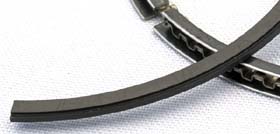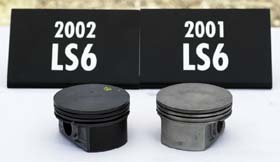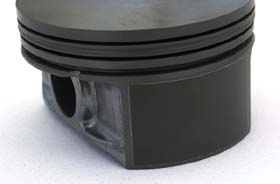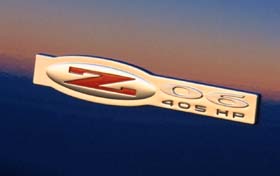| Ruthless Pursuit of Power: The Sequel |
Page5 |
|||||||||||||||||||
|
Fixes for Oil Use and Piston Slap A hot topic amongst Gen III-powered Corvette and F-cars enthusiasts, especially those active on the Internet, is high oil consumption. We asked Juriga about this and he confirmed there’s a problem, but not one as widespread as some people believe. He also explained the fix GM Powertrain has developed for it. "We have seen a greater percentage of complaints than we’d like about oil consumption," John admitted. "The condition under which we get that oil consumption is high-rpm, light-load–like if you drive in a city schedule but never take the car out of second gear. In that situation, the piston rings can get into a flutter condition and that’s when the oil consumption takes place." Piston ring seal depends on a balance of four forces: combustion pressure, ring inertia, the ring’s radial expansion pressure and crankcase pressure. Ring flutter is uncontrolled oscillation due to an imbalance of those forces. Once a piston’s rings go into flutter, their ability to scrape oil off the cylinder wall as the piston moves downward is impaired, blow-by increases and oil consumption rises dramatically. The combination of high rpm and low crankcase pressure typical of low engine loads causes those four forces to become imbalanced. The small amount of ’97-’01 LS1s and LS6es that see regular, high-rpm, light-load operation may suffer high oil consumption. "The severity of this problem is specific to the driver," Juriga continued. "You can take a car that is a major complaint for one customer and give it to another customer who’ll have (different driving habits and) no complaints and get 5000 miles to a quart." The common sense is that sustained high-speed and light-load is not a normal duty cycle, even for an engine in a car like a Corvette. Who drives around town running 4000 or more rpm at light-throttle? "It’s not the way most people normally drive," John agreed, "so it has not been a substantial part of our normal durability schedule. "It is a substantial part of our schedule, now. "This particular problem is not something you see as a wear issue, either. You can tear apart the engine and find nothing. In fact, that’s why it was so difficult. Someone says, ‘I have an oil consumption problem.’ We give the car to our guys who put a thousand miles on it and oil consumption is within limits. When we drive it aggressively, but in a more conventional manner, there’s no problem. We tear down the engine. Everything looks fine. No wear. No scored bores. No ring gap alignment problem. Nothing to explain the oil consumption. "This issue has become very pronounced on the Internet. People are saying, ‘Oh–we’ve got a problem with oil consumption.’ but the vast majority of customers don’t have any problem. There are a few who drive like that–and they’re entitled to, that’s why they buy a Corvette. They are the ones that have trouble and we want to try to help them." Internet conspiracy theories, urban legend and rumor mutate and spread rapidly. While the core issue, oil use, has factual basis; it quickly became exaggerated and laced with disinformation. To verify a problem like this then develop and test a successful fix is difficult and time consuming. Initially, during the years the only engine was the LS1, complaints were limited in number and isolated. This is why General Motors has seemed slow to respond. "Our investigation into those complaints took time," Juriga continued, "due to the fact that driving style had been determined to be a factor. "The consumption became more pronounced with the higher rpm operating range of the (’01) LS6 and, therefore (it was) possible for us to evaluate correctly. As soon as the (test) data came in from '01, we had an improvement for '02. Let the customer rest assured: the cases that have come in are from the non-typical driver. By far, most customers are not experiencing abnormal oil consumption. GMPT contacted customers experiencing the problem. This
group was asked specific questions about driving habits. Once GM acquired
data pointing at the difficulty, it devised a test schedule that could be
run under controlled conditions and would include some high-speed,
light-load operation. Once GM did that, then tore down engines and found
no wear, materials or assembly trouble; ring-flutter-driven, oil
consumption was identified as the cause.
"We’ve had over a dozen customers with complaint vehicles," John Juriga stated. "We put these rings in and it’s a ‘clean kill.’ It takes customers who are aggressive drivers and who had oil consumption as low as 500-800 miles per quart up to 1500-2000 miles a quart. This fix is available through the service organization. Dealers will disassemble the engines and change the rings. "It’s on a case-by-case basis because, with some customers, all you have to do is tell them, ‘You can eliminate your problem if you throw it into third or fourth gear instead of riding it in second.’ They’ll be happy to do that and the problem goes away. "Other customers say, ‘No. That’s why I bought my ‘Vette. I’m gonna drive it the way I wanna drive it.’ If so, that’s fine. At this time, there isn't a threshold other than what is standard with our other engines. If a customer is experiencing oil consumption of more than a quart per 2000 miles they can have it reviewed by a GM dealer which then makes a determination as to follow up. If you’re getting 500-800 miles per quart, that’s too much and we’re going to swap the rings out in that engine." The revised ring package will not increase an engine’s performance. If you’re not experiencing excessive oil use, there’s no advantage in running out to get new rings. If you do have an engine that experiences abnormal oil use due to some high-rpm/light-load operation; first, try modifying your driving habits a bit to eliminate any sustained operation like that, rather than immediately electing for the trauma of a partial engine overhaul under warranty. If eliminating most high-rpm/light-load operation doesn’t stop excessive oil use, then ask GM to repair the engine. Some involved in the public dialog about this issue have been critical of General Motors. It’s our opinion that some of the harshest rhetoric is unfounded because this problem is not as common as Internet rumor claims nor does it stem from some coverup conspiracy to stick unsuspecting customers with substandard products. While it’s clear to us General Motors erred in not making high-rpm/light-load testing as prominent as it should have been, thus, failing to detect trouble with ring-flutter; this issue does beg the question: should a small group of owners who subject their engines to the unusual duty-cycle of sustained high-rpm/light-load operation share part of the responsibility for this problem? Going to a higher tension oil ring and a Napier profile second ring solves the oil use problem convincingly. Will the change also result in oil consumption decreases in LS1s and LS6es which are driven normally or driven aggressively, but not in the high-rpm/light-load manner that previously caused ring flutter? There is that possibility. In mid-April ’01, there was a change in the LS1/LS6
piston which carried over to MY02. To address a limited amount of
complaints about "cold piston knock", there was a small
reduction in piston-to-bore clearance and new pistons, having skirts
coated with a polymer, antifriction material, were introduced. "When you decrease the piston-to-bore clearance, you’re more susceptible to hot-scuff because you’ve got a tighter fit. The coating gives us resistance against scuffing," Juriga stated. When asked about possible power losses, he added, "We haven’t seen any measurable hit from a power standpoint because of the tighter clearance." The LS1/LS6 are first in the Gen III family to use coated pistons. Corvette often leads the way with new technology that eventually sees high volume production. In the near future, all Gen IIIs used in GM trucks will have coated pistons–we’re talking millions of engines a year, here, not just 90,000 or so C5, Camaro/Firebird and export (to Holden’s in Australia) powerplants annually.
|
||||||||||||||||||||





